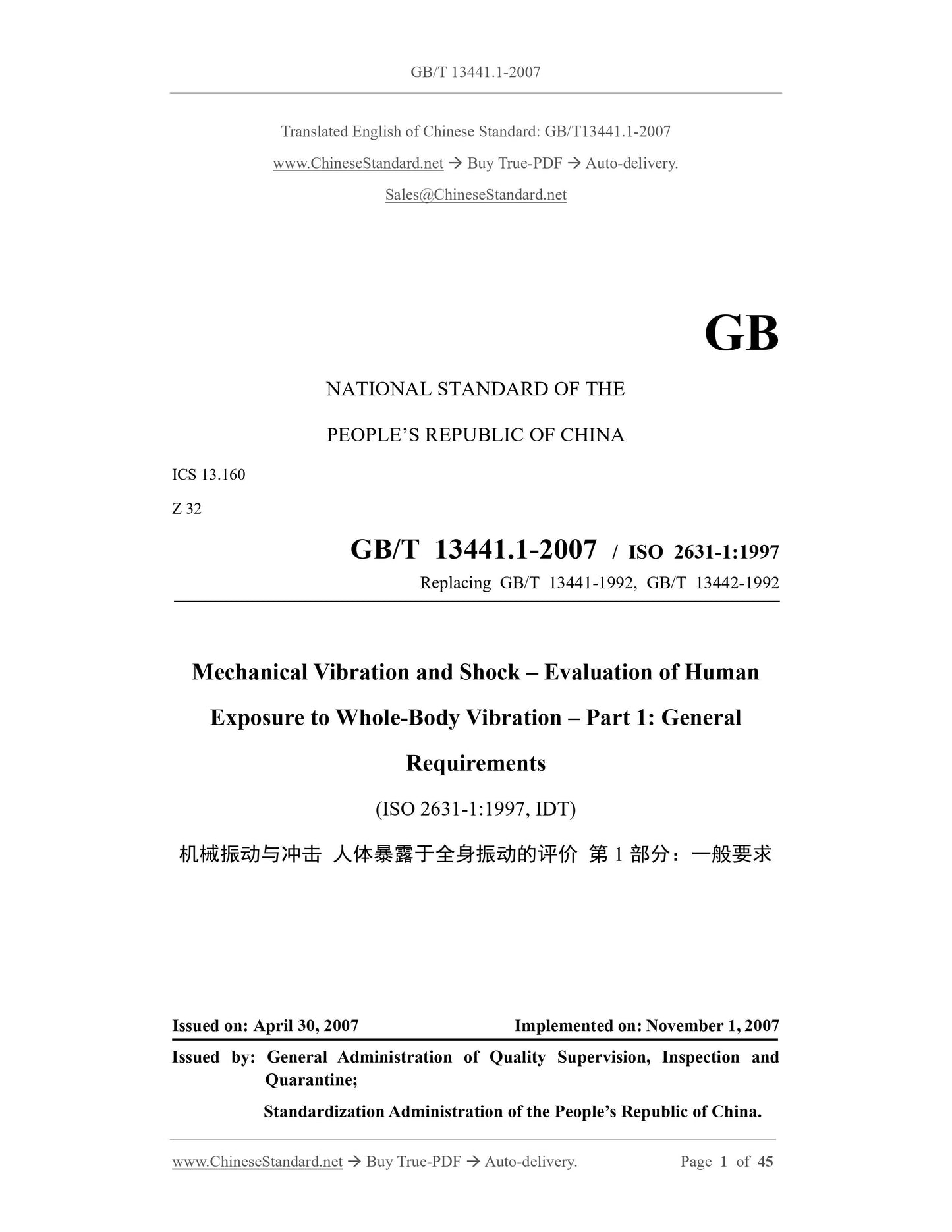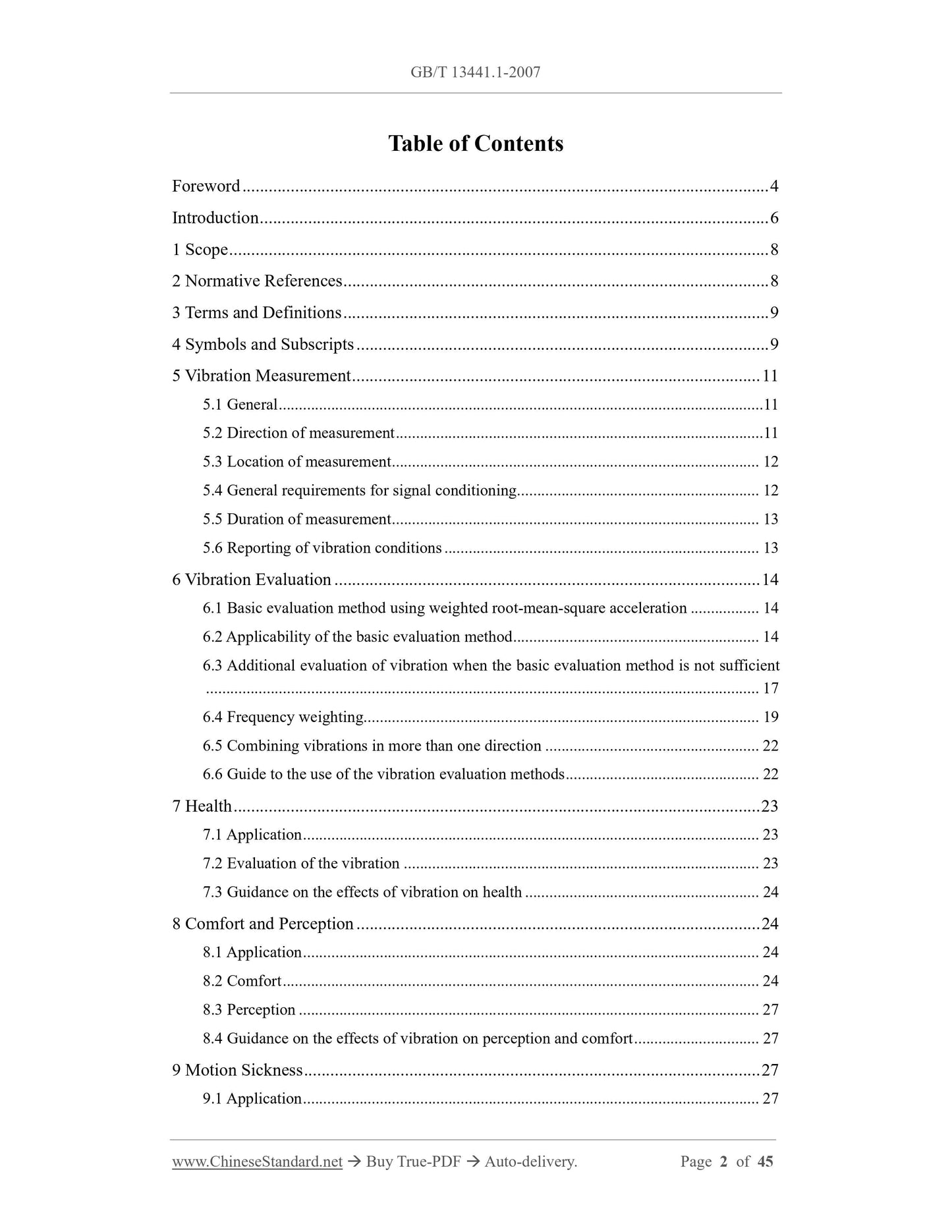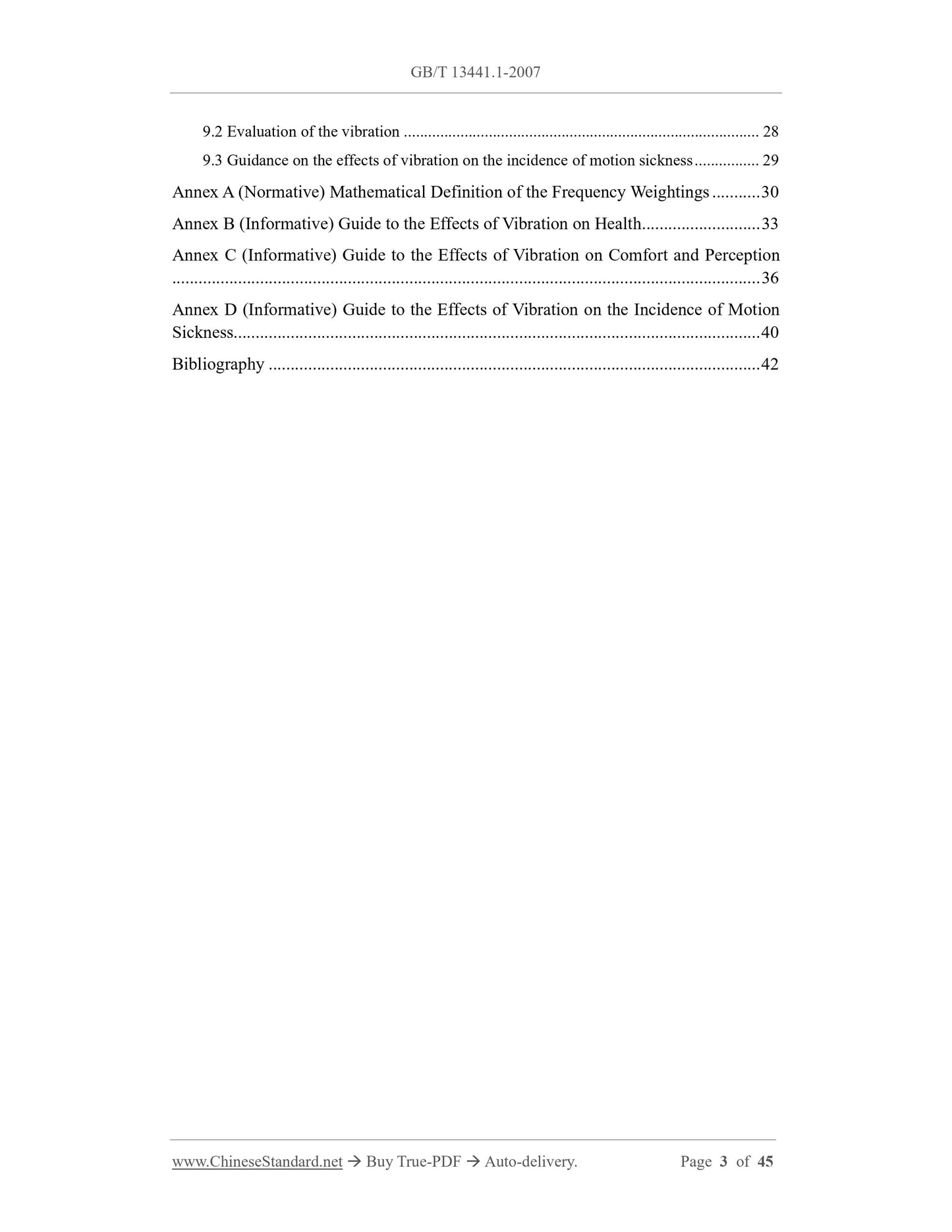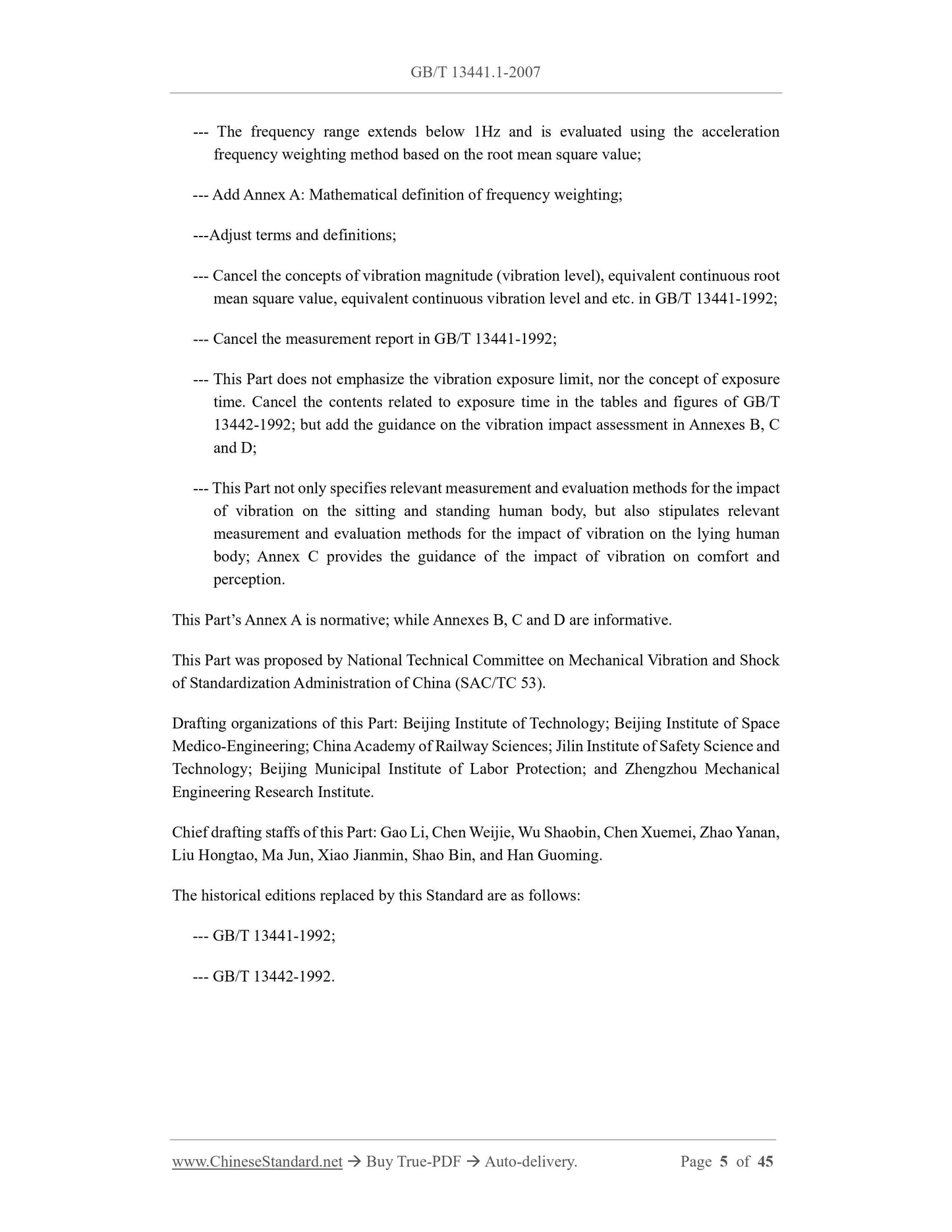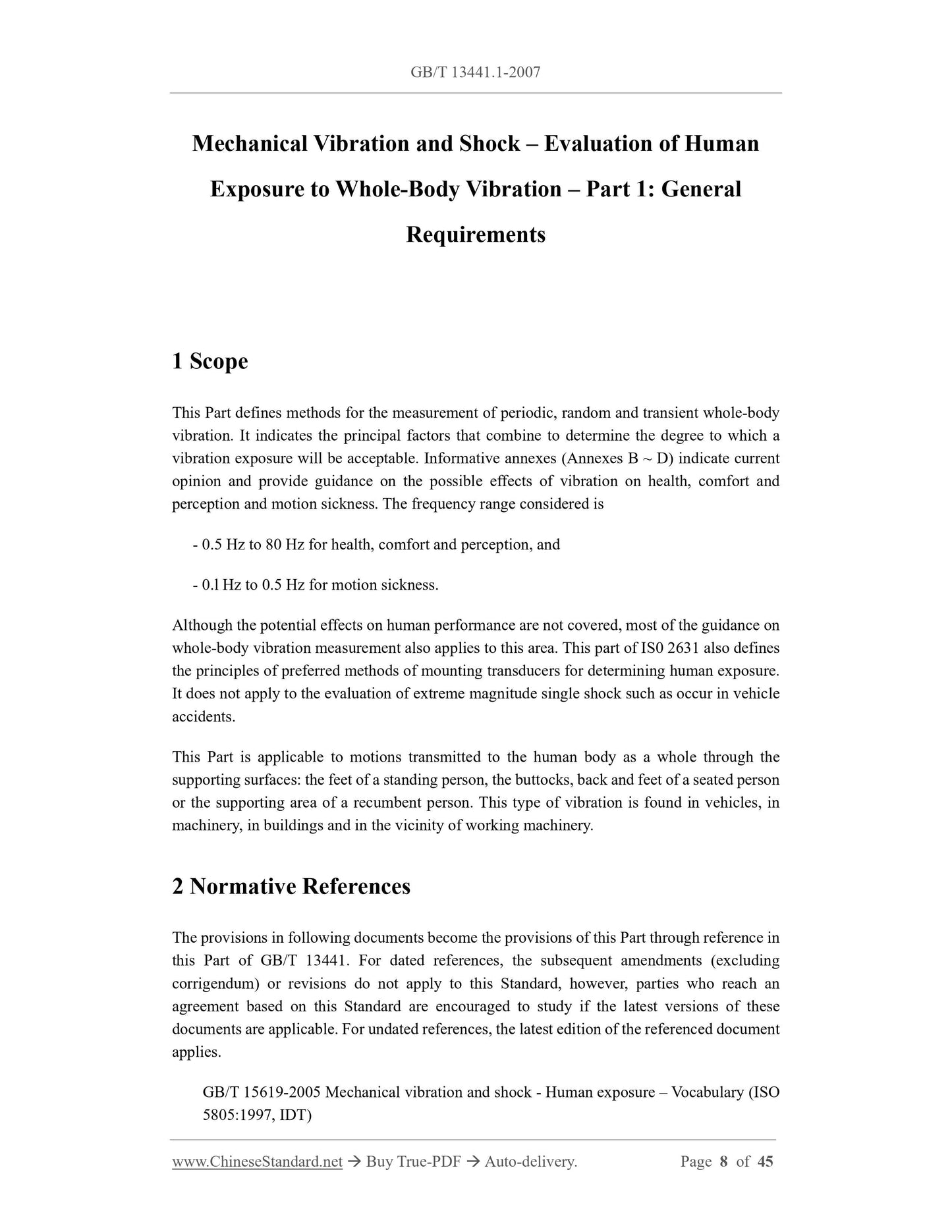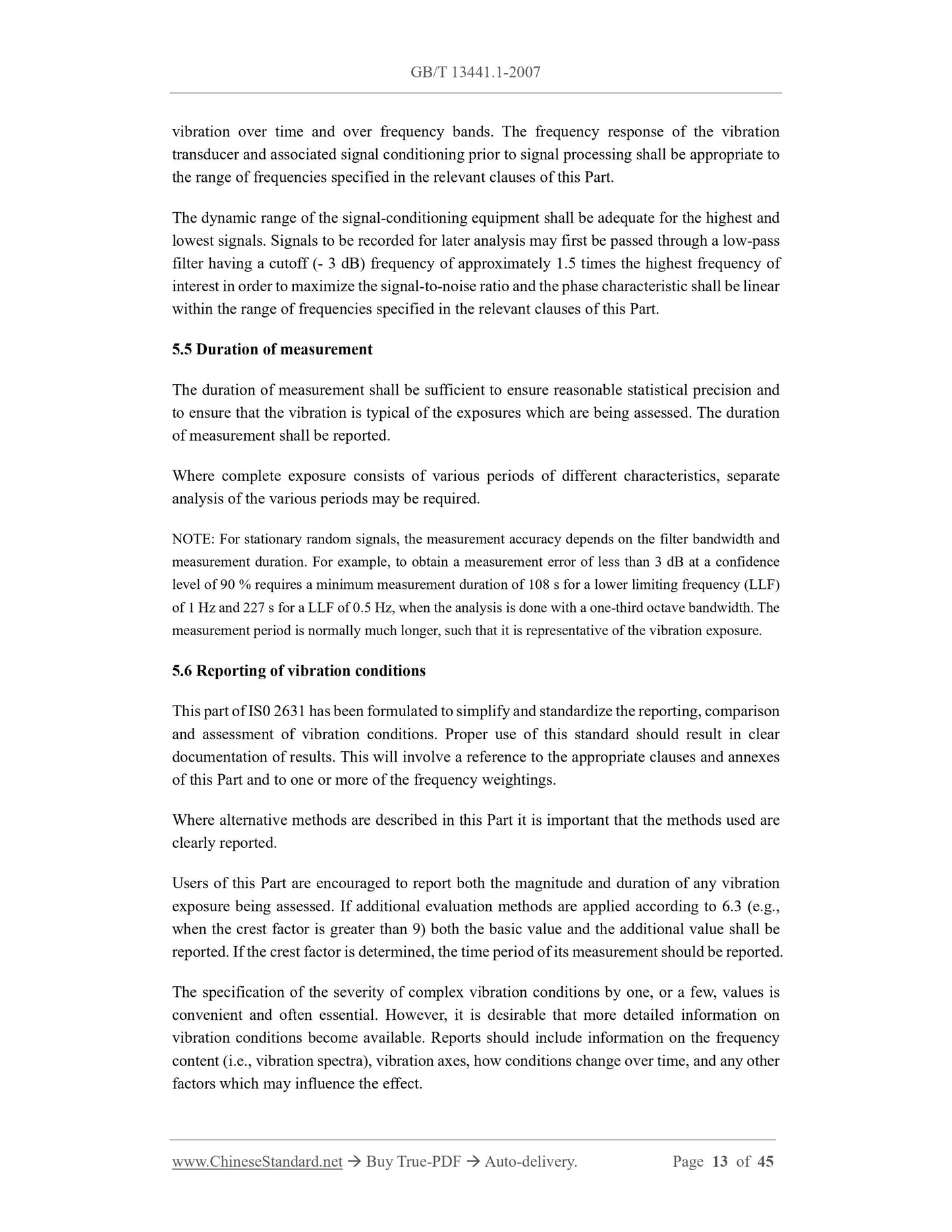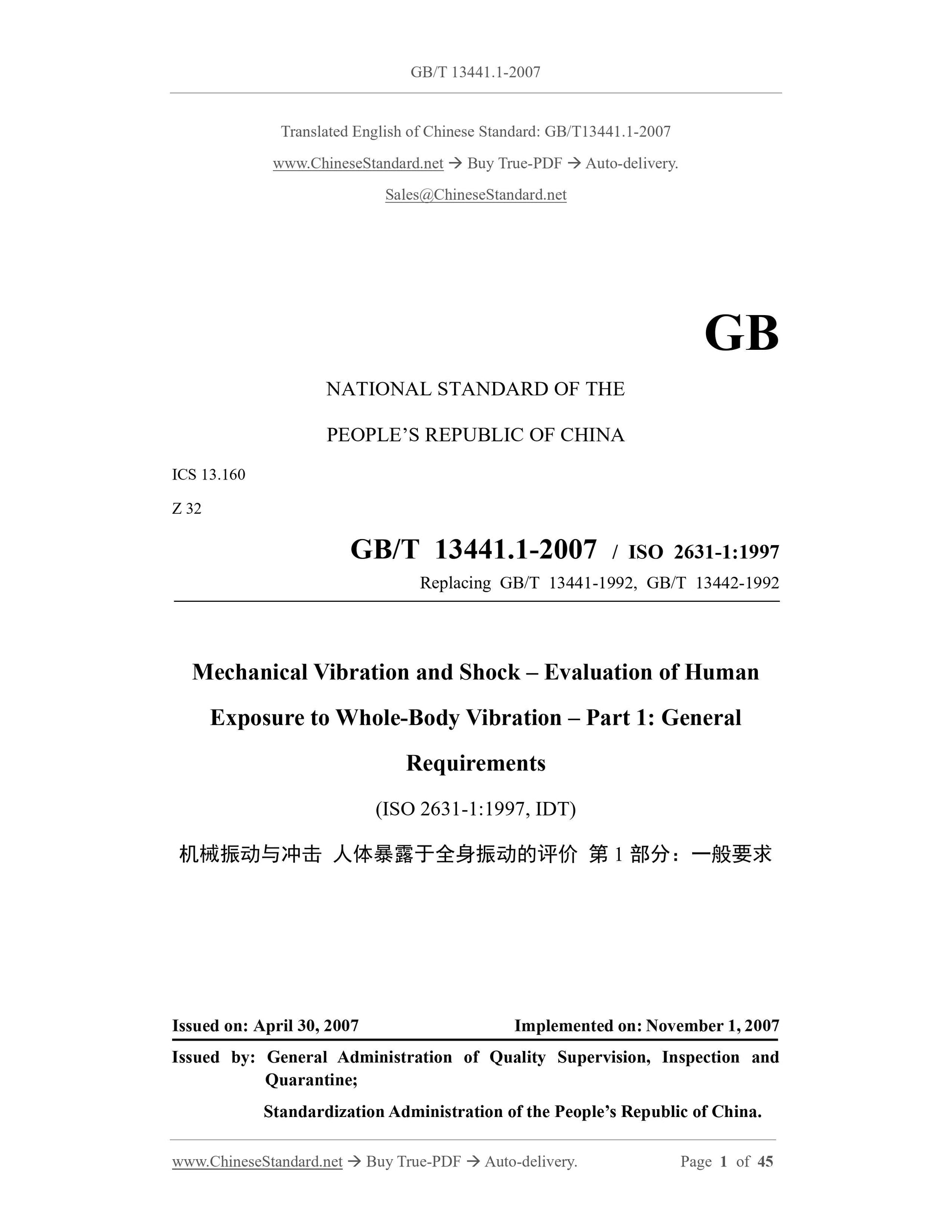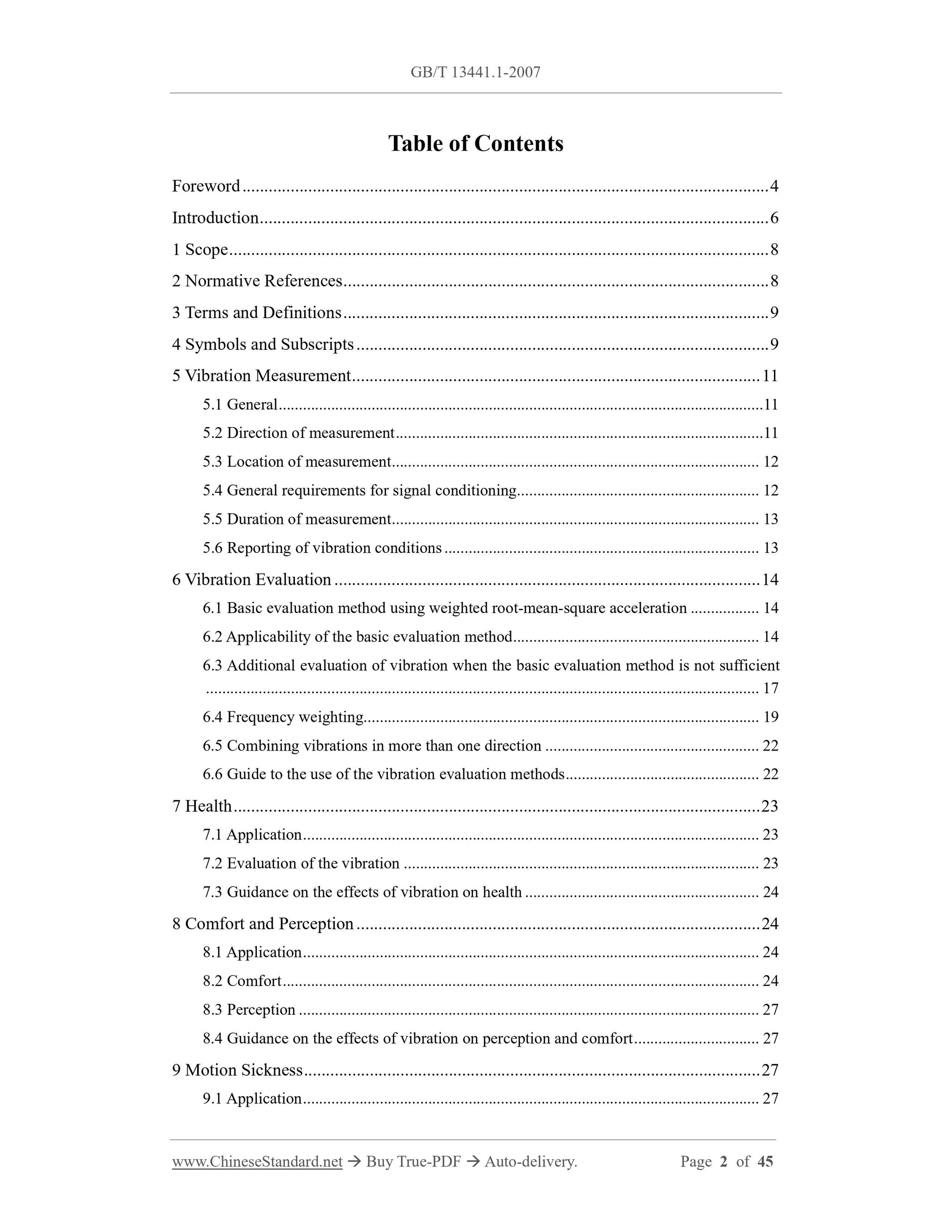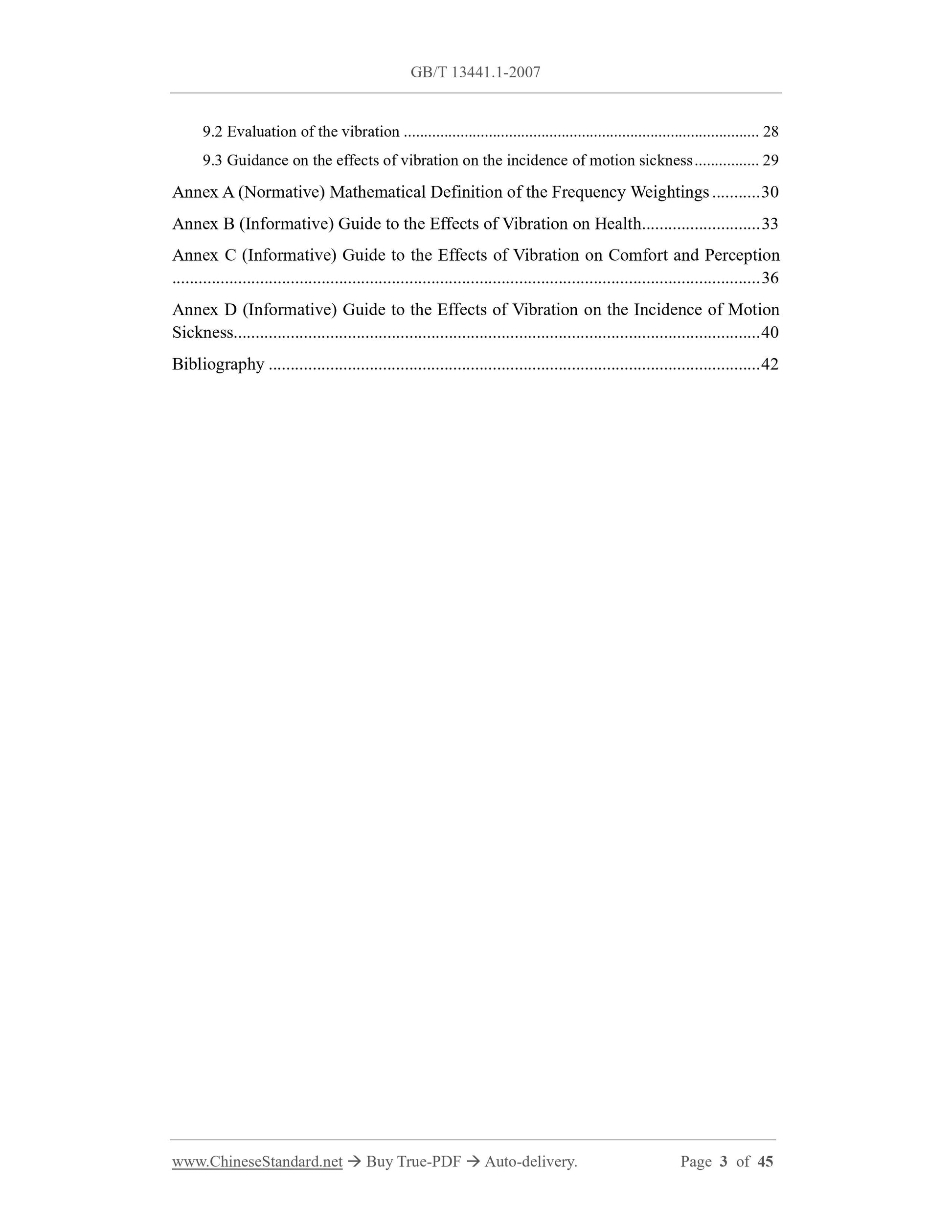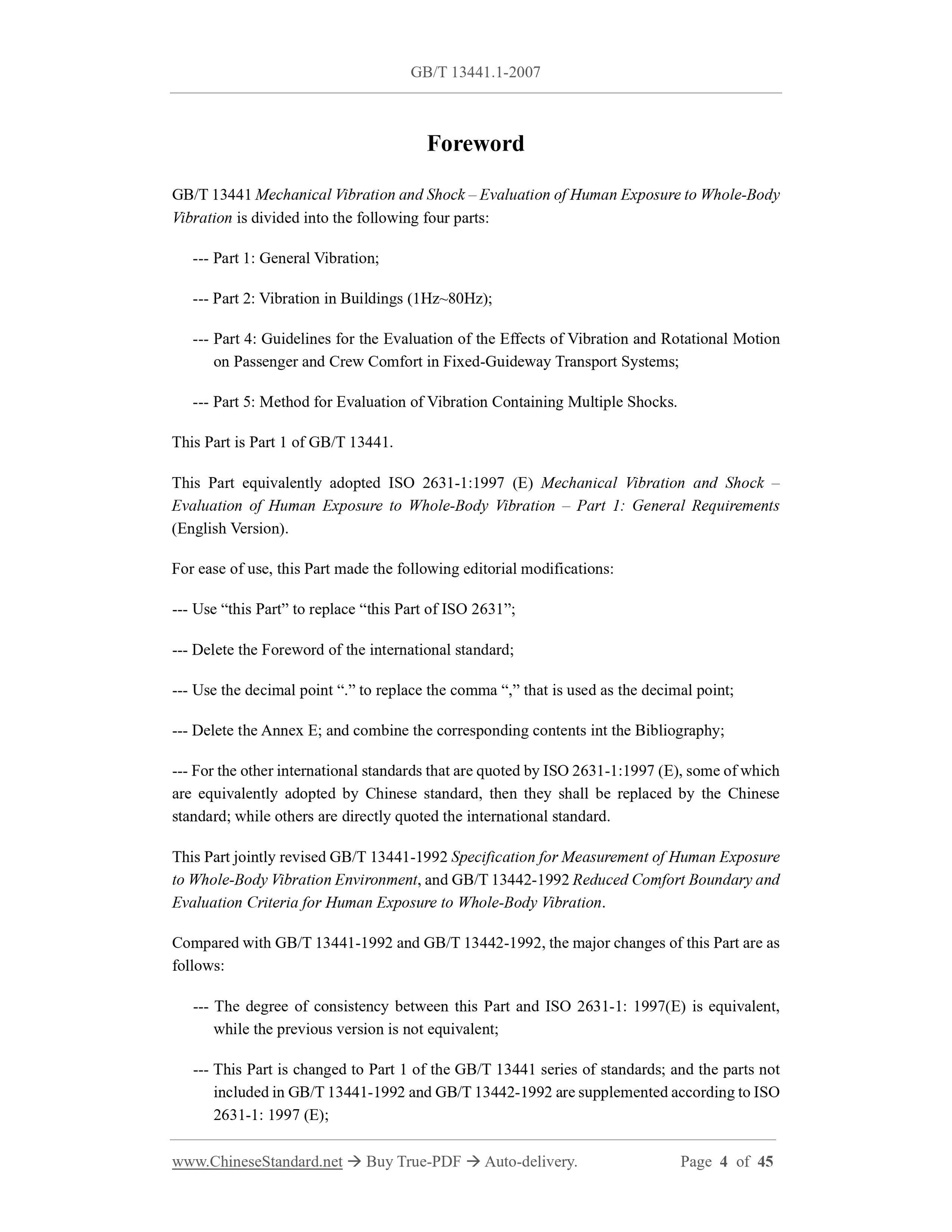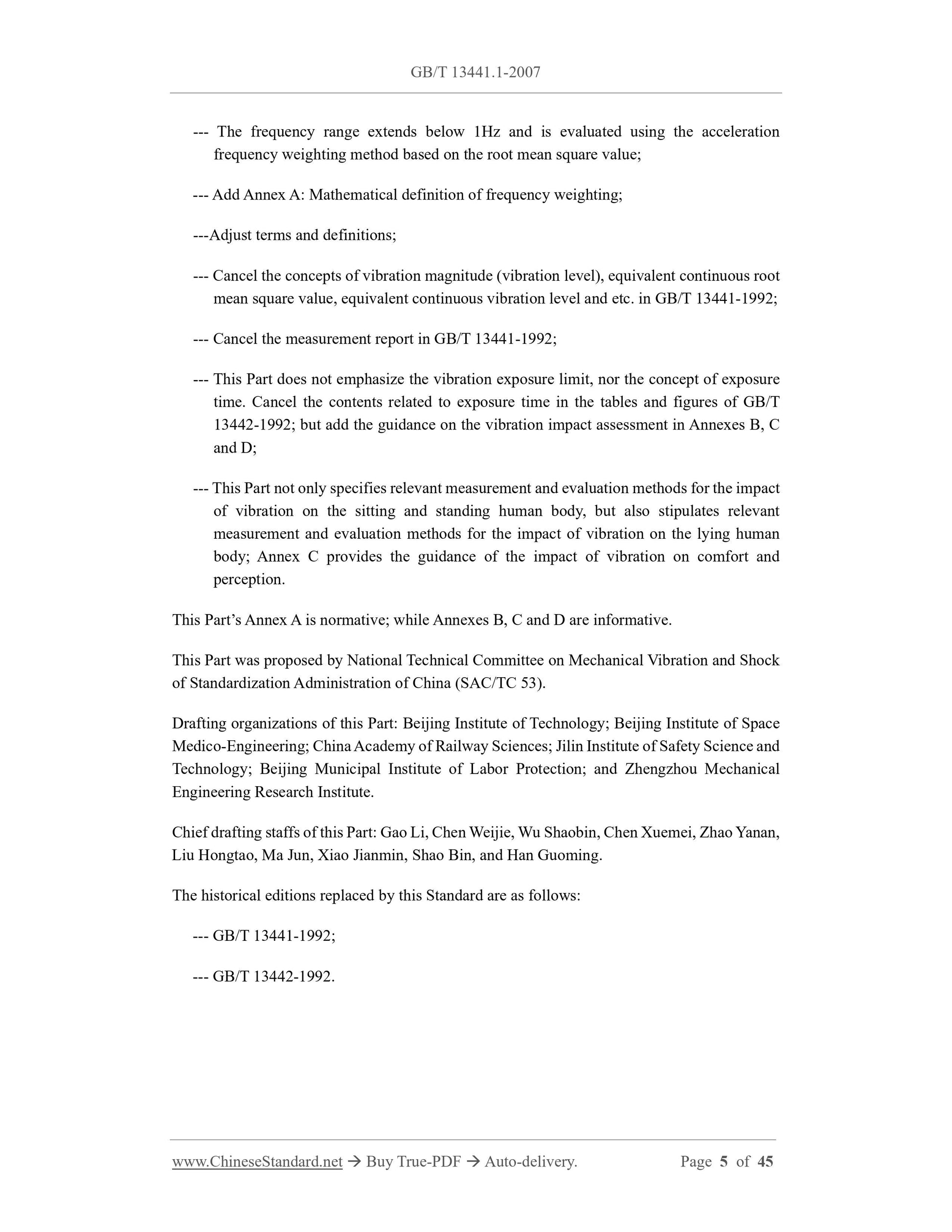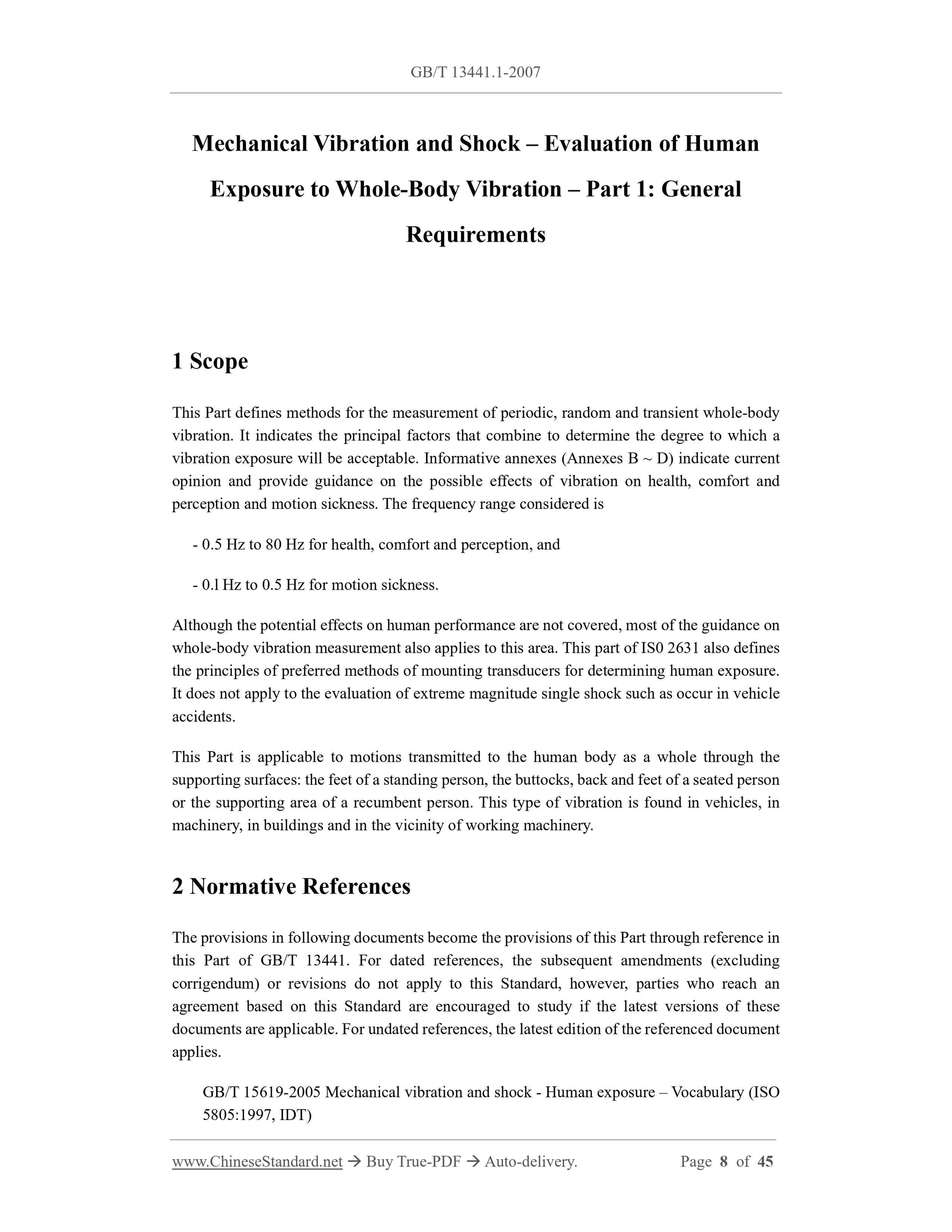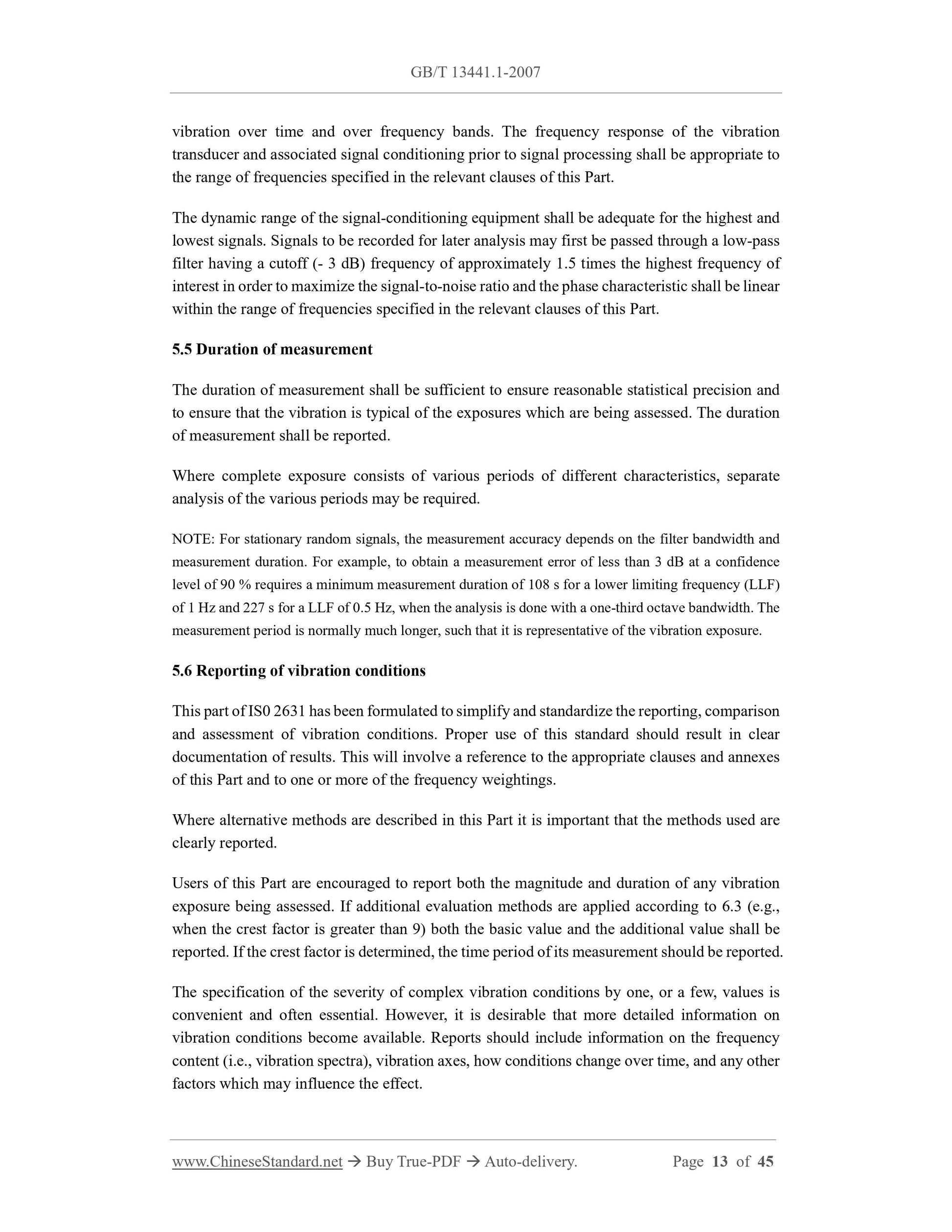1
/
of
7
PayPal, credit cards. Download editable-PDF and invoice in 1 second!
GB/T 13441.1-2007 English PDF (GBT13441.1-2007)
GB/T 13441.1-2007 English PDF (GBT13441.1-2007)
Regular price
$400.00 USD
Regular price
Sale price
$400.00 USD
Unit price
/
per
Shipping calculated at checkout.
Couldn't load pickup availability
Delivery: 3 seconds. Download true-PDF + Invoice.
Get QUOTATION in 1-minute: Click GB/T 13441.1-2007
Historical versions: GB/T 13441.1-2007
Preview True-PDF (Reload/Scroll if blank)
GB/T 13441.1-2007: Mechanical vibration and shock -- Evaluation of human exposure to whole-body vibration -- Part 1: General requirements
GB/T 13441.1-2007
GB
NATIONAL STANDARD OF THE
PEOPLE’S REPUBLIC OF CHINA
ICS 13.160
Z 32
GB/T 13441.1-2007 / ISO 2631-1:1997
Replacing GB/T 13441-1992, GB/T 13442-1992
Mechanical Vibration and Shock – Evaluation of Human
Exposure to Whole-Body Vibration – Part 1: General
Requirements
(ISO 2631-1:1997, IDT)
ISSUED ON: APRIL 30, 2007
IMPLEMENTED ON: NOVEMBER 1, 2007
Issued by: General Administration of Quality Supervision, Inspection and
Quarantine;
Standardization Administration of the People’s Republic of China.
Table of Contents
Foreword ... 4
Introduction ... 6
1 Scope ... 8
2 Normative References ... 8
3 Terms and Definitions ... 9
4 Symbols and Subscripts ... 9
5 Vibration Measurement ... 11
5.1 General ... 11
5.2 Direction of measurement ... 11
5.3 Location of measurement ... 12
5.4 General requirements for signal conditioning ... 12
5.5 Duration of measurement ... 13
5.6 Reporting of vibration conditions ... 13
6 Vibration Evaluation ... 14
6.1 Basic evaluation method using weighted root-mean-square acceleration ... 14
6.2 Applicability of the basic evaluation method ... 14
6.3 Additional evaluation of vibration when the basic evaluation method is not sufficient
... 17
6.4 Frequency weighting ... 19
6.5 Combining vibrations in more than one direction ... 22
6.6 Guide to the use of the vibration evaluation methods ... 22
7 Health ... 23
7.1 Application ... 23
7.2 Evaluation of the vibration ... 23
7.3 Guidance on the effects of vibration on health ... 24
8 Comfort and Perception ... 24
8.1 Application ... 24
8.2 Comfort ... 24
8.3 Perception ... 27
8.4 Guidance on the effects of vibration on perception and comfort ... 27
9 Motion Sickness ... 27
9.1 Application ... 27
9.2 Evaluation of the vibration ... 28
9.3 Guidance on the effects of vibration on the incidence of motion sickness ... 29
Annex A (Normative) Mathematical Definition of the Frequency Weightings ... 30
Annex B (Informative) Guide to the Effects of Vibration on Health ... 33
Annex C (Informative) Guide to the Effects of Vibration on Comfort and Perception
... 36
Annex D (Informative) Guide to the Effects of Vibration on the Incidence of Motion
Sickness... 40
Bibliography ... 42
Foreword
GB/T 13441 Mechanical Vibration and Shock – Evaluation of Human Exposure to Whole-Body
Vibration is divided into the following four parts:
--- Part 1: General Vibration;
--- Part 2: Vibration in Buildings (1Hz~80Hz);
--- Part 4: Guidelines for the Evaluation of the Effects of Vibration and Rotational Motion
on Passenger and Crew Comfort in Fixed-Guideway Transport Systems;
--- Part 5: Method for Evaluation of Vibration Containing Multiple Shocks.
This Part is Part 1 of GB/T 13441.
This Part equivalently adopted ISO 2631-1:1997 (E) Mechanical Vibration and Shock –
Evaluation of Human Exposure to Whole-Body Vibration – Part 1: General Requirements
(English Version).
For ease of use, this Part made the following editorial modifications:
--- Use “this Part” to replace “this Part of ISO 2631”;
--- Delete the Foreword of the international standard;
--- Use the decimal point “.” to replace the comma “,” that is used as the decimal point;
--- Delete the Annex E; and combine the corresponding contents int the Bibliography;
--- For the other international standards that are quoted by ISO 2631-1:1997 (E), some of which
are equivalently adopted by Chinese standard, then they shall be replaced by the Chinese
standard; while others are directly quoted the international standard.
This Part jointly revised GB/T 13441-1992 Specification for Measurement of Human Exposure
to Whole-Body Vibration Environment, and GB/T 13442-1992 Reduced Comfort Boundary and
Evaluation Criteria for Human Exposure to Whole-Body Vibration.
Compared with GB/T 13441-1992 and GB/T 13442-1992, the major changes of this Part are as
follows:
--- The degree of consistency between this Part and ISO 2631-1: 1997(E) is equivalent,
while the previous version is not equivalent;
--- This Part is changed to Part 1 of the GB/T 13441 series of standards; and the parts not
included in GB/T 13441-1992 and GB/T 13442-1992 are supplemented according to ISO
2631-1: 1997 (E);
--- The frequency range extends below 1Hz and is evaluated using the acceleration
frequency weighting method based on the root mean square value;
--- Add Annex A: Mathematical definition of frequency weighting;
---Adjust terms and definitions;
--- Cancel the concepts of vibration magnitude (vibration level), equivalent continuous root
mean square value, equivalent continuous vibration level and etc. in GB/T 13441-1992;
--- Cancel the measurement report in GB/T 13441-1992;
--- This Part does not emphasize the vibration exposure limit, nor the concept of exposure
time. Cancel the contents related to exposure time in the tables and figures of GB/T
13442-1992; but add the guidance on the vibration impact assessment in Annexes B, C
and D;
--- This Part not only specifies relevant measurement and evaluation methods for the impact
of vibration on the sitting and standing human body, but also stipulates relevant
measurement and evaluation methods for the impact of vibration on the lying human
body; Annex C provides the guidance of the impact of vibration on comfort and
perception.
This Part’s Annex A is normative; while Annexes B, C and D are informative.
This Part was proposed by National Technical Committee on Mechanical Vibration and Shock
of Standardization Administration of China (SAC/TC 53).
Drafting organizations of this Part: Beijing Institute of Technology; Beijing Institute of Space
Medico-Engineering; China Academy of Railway Sciences; Jilin Institute of Safety Science and
Technology; Beijing Municipal Institute of Labor Protection; and Zhengzhou Mechanical
Engineering Research Institute.
Chief drafting staffs of this Part: Gao Li, Chen Weijie, Wu Shaobin, Chen Xuemei, Zhao Yanan,
Liu Hongtao, Ma Jun, Xiao Jianmin, Shao Bin, and Han Guoming.
The historical editions replaced by this Standard are as follows:
--- GB/T 13441-1992;
--- GB/T 13442-1992.
Mechanical Vibration and Shock – Evaluation of Human
Exposure to Whole-Body Vibration – Part 1: General
Requirements
1 Scope
This Part defines methods for the measurement of periodic, random and transient whole-body
vibration. It indicates the principal factors that combine to determine the degree to which a
vibration exposure will be acceptable. Informative annexes (Annexes B ~ D) indicate current
opinion and provide guidance on the possible effects of vibration on health, comfort and
perception and motion sickness. The frequency range considered is
- 0.5 Hz to 80 Hz for health, comfort and perception, and
- 0.l Hz to 0.5 Hz for motion sickness.
Although the potential effects on human performance are not covered, most of the guidance on
whole-body vibration measurement also applies to this area. This part of IS0 2631 also defines
the principles of preferred methods of mounting transducers for determining human exposure.
It does not apply to the evaluation of extreme magnitude single shock such as occur in vehicle
accidents.
This Part is applicable to motions transmitted to the human body as a whole through the
supporting surfaces: the feet of a standing person, the buttocks, back and feet of a seated person
or the supporting area of a recumbent person. This type of vibration is ...
Get QUOTATION in 1-minute: Click GB/T 13441.1-2007
Historical versions: GB/T 13441.1-2007
Preview True-PDF (Reload/Scroll if blank)
GB/T 13441.1-2007: Mechanical vibration and shock -- Evaluation of human exposure to whole-body vibration -- Part 1: General requirements
GB/T 13441.1-2007
GB
NATIONAL STANDARD OF THE
PEOPLE’S REPUBLIC OF CHINA
ICS 13.160
Z 32
GB/T 13441.1-2007 / ISO 2631-1:1997
Replacing GB/T 13441-1992, GB/T 13442-1992
Mechanical Vibration and Shock – Evaluation of Human
Exposure to Whole-Body Vibration – Part 1: General
Requirements
(ISO 2631-1:1997, IDT)
ISSUED ON: APRIL 30, 2007
IMPLEMENTED ON: NOVEMBER 1, 2007
Issued by: General Administration of Quality Supervision, Inspection and
Quarantine;
Standardization Administration of the People’s Republic of China.
Table of Contents
Foreword ... 4
Introduction ... 6
1 Scope ... 8
2 Normative References ... 8
3 Terms and Definitions ... 9
4 Symbols and Subscripts ... 9
5 Vibration Measurement ... 11
5.1 General ... 11
5.2 Direction of measurement ... 11
5.3 Location of measurement ... 12
5.4 General requirements for signal conditioning ... 12
5.5 Duration of measurement ... 13
5.6 Reporting of vibration conditions ... 13
6 Vibration Evaluation ... 14
6.1 Basic evaluation method using weighted root-mean-square acceleration ... 14
6.2 Applicability of the basic evaluation method ... 14
6.3 Additional evaluation of vibration when the basic evaluation method is not sufficient
... 17
6.4 Frequency weighting ... 19
6.5 Combining vibrations in more than one direction ... 22
6.6 Guide to the use of the vibration evaluation methods ... 22
7 Health ... 23
7.1 Application ... 23
7.2 Evaluation of the vibration ... 23
7.3 Guidance on the effects of vibration on health ... 24
8 Comfort and Perception ... 24
8.1 Application ... 24
8.2 Comfort ... 24
8.3 Perception ... 27
8.4 Guidance on the effects of vibration on perception and comfort ... 27
9 Motion Sickness ... 27
9.1 Application ... 27
9.2 Evaluation of the vibration ... 28
9.3 Guidance on the effects of vibration on the incidence of motion sickness ... 29
Annex A (Normative) Mathematical Definition of the Frequency Weightings ... 30
Annex B (Informative) Guide to the Effects of Vibration on Health ... 33
Annex C (Informative) Guide to the Effects of Vibration on Comfort and Perception
... 36
Annex D (Informative) Guide to the Effects of Vibration on the Incidence of Motion
Sickness... 40
Bibliography ... 42
Foreword
GB/T 13441 Mechanical Vibration and Shock – Evaluation of Human Exposure to Whole-Body
Vibration is divided into the following four parts:
--- Part 1: General Vibration;
--- Part 2: Vibration in Buildings (1Hz~80Hz);
--- Part 4: Guidelines for the Evaluation of the Effects of Vibration and Rotational Motion
on Passenger and Crew Comfort in Fixed-Guideway Transport Systems;
--- Part 5: Method for Evaluation of Vibration Containing Multiple Shocks.
This Part is Part 1 of GB/T 13441.
This Part equivalently adopted ISO 2631-1:1997 (E) Mechanical Vibration and Shock –
Evaluation of Human Exposure to Whole-Body Vibration – Part 1: General Requirements
(English Version).
For ease of use, this Part made the following editorial modifications:
--- Use “this Part” to replace “this Part of ISO 2631”;
--- Delete the Foreword of the international standard;
--- Use the decimal point “.” to replace the comma “,” that is used as the decimal point;
--- Delete the Annex E; and combine the corresponding contents int the Bibliography;
--- For the other international standards that are quoted by ISO 2631-1:1997 (E), some of which
are equivalently adopted by Chinese standard, then they shall be replaced by the Chinese
standard; while others are directly quoted the international standard.
This Part jointly revised GB/T 13441-1992 Specification for Measurement of Human Exposure
to Whole-Body Vibration Environment, and GB/T 13442-1992 Reduced Comfort Boundary and
Evaluation Criteria for Human Exposure to Whole-Body Vibration.
Compared with GB/T 13441-1992 and GB/T 13442-1992, the major changes of this Part are as
follows:
--- The degree of consistency between this Part and ISO 2631-1: 1997(E) is equivalent,
while the previous version is not equivalent;
--- This Part is changed to Part 1 of the GB/T 13441 series of standards; and the parts not
included in GB/T 13441-1992 and GB/T 13442-1992 are supplemented according to ISO
2631-1: 1997 (E);
--- The frequency range extends below 1Hz and is evaluated using the acceleration
frequency weighting method based on the root mean square value;
--- Add Annex A: Mathematical definition of frequency weighting;
---Adjust terms and definitions;
--- Cancel the concepts of vibration magnitude (vibration level), equivalent continuous root
mean square value, equivalent continuous vibration level and etc. in GB/T 13441-1992;
--- Cancel the measurement report in GB/T 13441-1992;
--- This Part does not emphasize the vibration exposure limit, nor the concept of exposure
time. Cancel the contents related to exposure time in the tables and figures of GB/T
13442-1992; but add the guidance on the vibration impact assessment in Annexes B, C
and D;
--- This Part not only specifies relevant measurement and evaluation methods for the impact
of vibration on the sitting and standing human body, but also stipulates relevant
measurement and evaluation methods for the impact of vibration on the lying human
body; Annex C provides the guidance of the impact of vibration on comfort and
perception.
This Part’s Annex A is normative; while Annexes B, C and D are informative.
This Part was proposed by National Technical Committee on Mechanical Vibration and Shock
of Standardization Administration of China (SAC/TC 53).
Drafting organizations of this Part: Beijing Institute of Technology; Beijing Institute of Space
Medico-Engineering; China Academy of Railway Sciences; Jilin Institute of Safety Science and
Technology; Beijing Municipal Institute of Labor Protection; and Zhengzhou Mechanical
Engineering Research Institute.
Chief drafting staffs of this Part: Gao Li, Chen Weijie, Wu Shaobin, Chen Xuemei, Zhao Yanan,
Liu Hongtao, Ma Jun, Xiao Jianmin, Shao Bin, and Han Guoming.
The historical editions replaced by this Standard are as follows:
--- GB/T 13441-1992;
--- GB/T 13442-1992.
Mechanical Vibration and Shock – Evaluation of Human
Exposure to Whole-Body Vibration – Part 1: General
Requirements
1 Scope
This Part defines methods for the measurement of periodic, random and transient whole-body
vibration. It indicates the principal factors that combine to determine the degree to which a
vibration exposure will be acceptable. Informative annexes (Annexes B ~ D) indicate current
opinion and provide guidance on the possible effects of vibration on health, comfort and
perception and motion sickness. The frequency range considered is
- 0.5 Hz to 80 Hz for health, comfort and perception, and
- 0.l Hz to 0.5 Hz for motion sickness.
Although the potential effects on human performance are not covered, most of the guidance on
whole-body vibration measurement also applies to this area. This part of IS0 2631 also defines
the principles of preferred methods of mounting transducers for determining human exposure.
It does not apply to the evaluation of extreme magnitude single shock such as occur in vehicle
accidents.
This Part is applicable to motions transmitted to the human body as a whole through the
supporting surfaces: the feet of a standing person, the buttocks, back and feet of a seated person
or the supporting area of a recumbent person. This type of vibration is ...
Share
